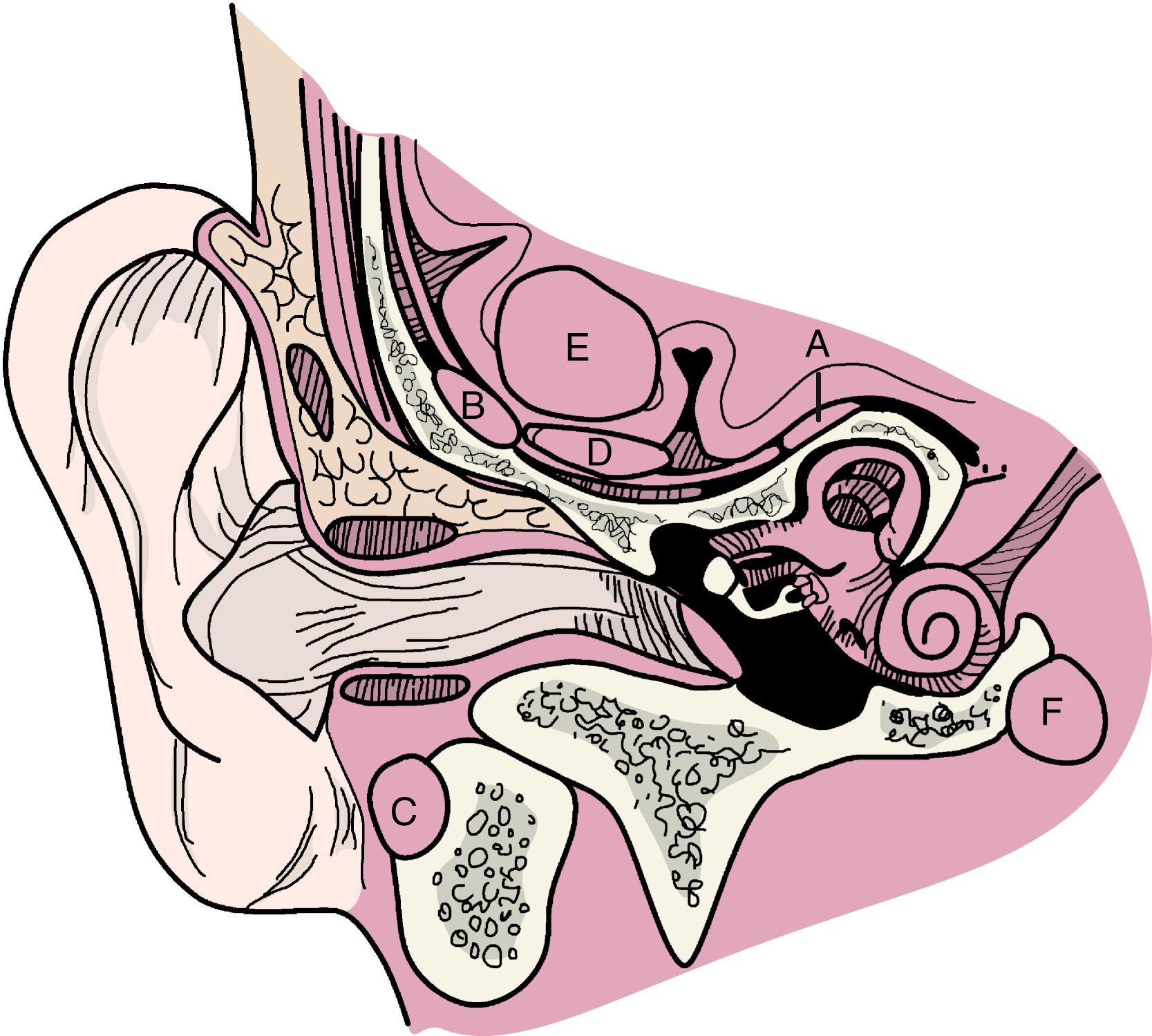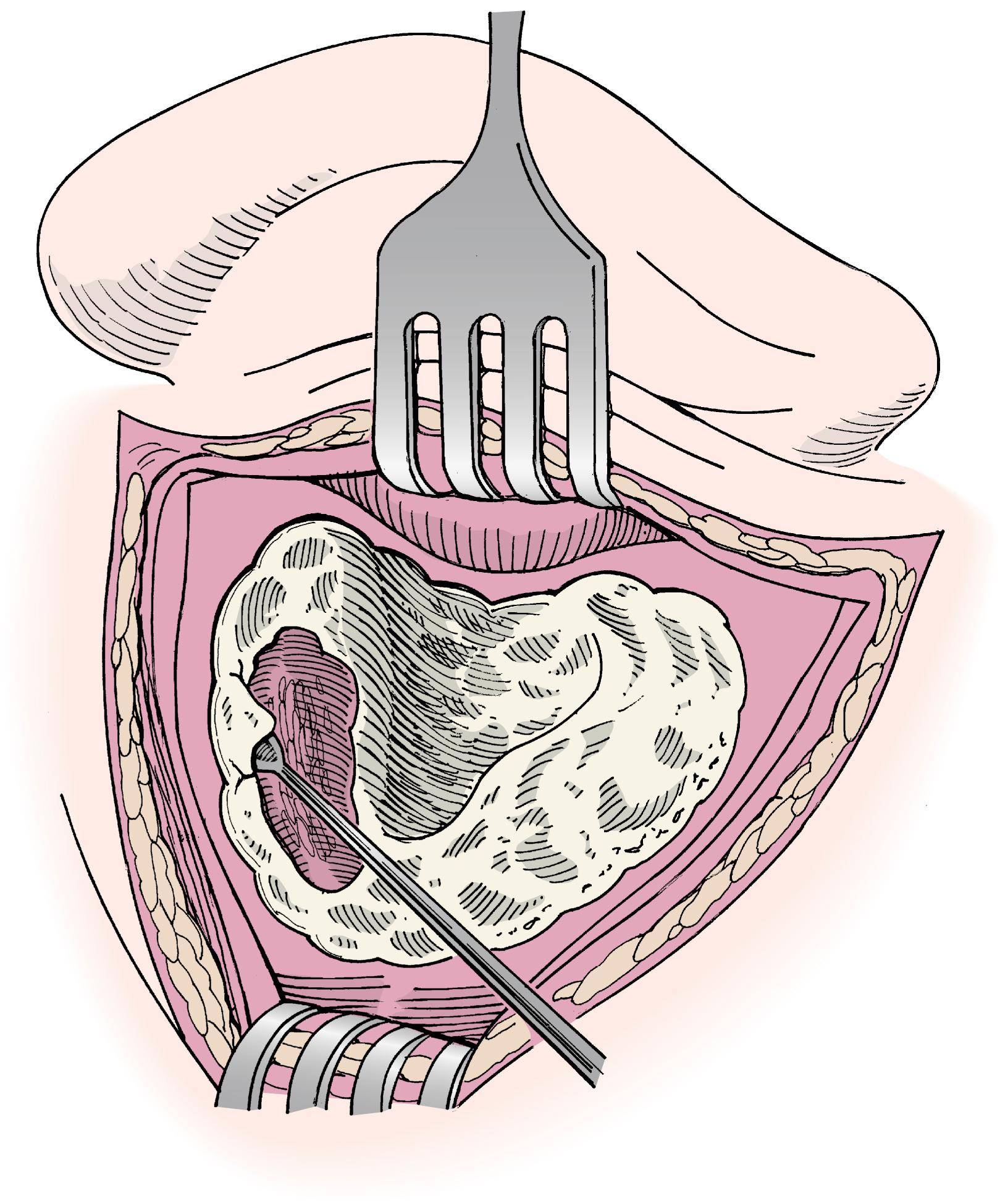Physical Address
304 North Cardinal St.
Dorchester Center, MA 02124
Complications from acute otitis media or chronic otitis media can be divided into extracranial complications (i.e., facial nerve paralysis, labyrinthitis, and subperiosteal abscess) and intracranial complications. Intracranial complications of otitis media include meningitis, epidural abscess, subdural abscess (empyema), brain abscess, lateral sinus thrombophlebitis/sigmoid sinus thrombosis, otitic hydrocephalus, and Gradenigo’s syndrome ( Fig. 130.1 ). On occasion, an intracranial complication may be the initial symptom in a patient with a history of untreated otitis media. It is also important to understand that multiple complications may often occur concomitantly, and the existence of one intracranial complication warrants investigation into the presence of others. Despite broad-spectrum antibiotics, complications of otitis media can result in high morbidity and even mortality, and surgical management is often necessary.

The spread of otitis media to intracranial structures may occur either directly or hematogenously. Direct extension can occur via multiple mechanisms: pre-existing congenital abnormalities (e.g., a Mondini deformity), posttraumatic bony defects from a fracture of the temporal bone, erosion of bony barriers as a result of cholesteatoma, normal communicating vein pathways from the mastoid to the intracranial space, and spontaneous or iatrogenic dehiscence of bone. Historically, meningitis has been and continues to be the most common intracranial complication of otitis media in children and adults, both in developed and underdeveloped countries. Epidural abscess and lateral sinus thrombosis have been reported as the next most common complications in children. Brain abscess, a rare complication in children in developed countries, is seen more commonly in the adult population and in less developed countries.
Patients may initially have the classic signs of otogenic infection, such as foul-smelling otorrhea, otalgia, headache, fever, vertigo, and sudden hearing loss. As the disease progresses, later signs include changes in mental status, such as confusion, obtundation or seizures, and cranial nerve palsies. Many patients with intracranial complications will have multiple complications, such as meningitis in addition to an intracranial abscess, and the Otolaryngologist should seek to diagnose and treat all of these complications. Patients may have concurrent intratemporal complications, such as subperiosteal abscess, labyrinthitis, and facial nerve paresis. When evaluating for the possibility of intracranial complications of otitis media, magnetic resonance imaging (MRI) provides better detail of intracranial structures than computed tomography (CT). The frequency of various intracranial complications in a number of case series is presented in Table 130.1 .
| Reference and Total Number of Patients | Patients with ICCOM | Meningitis | Epidural Abscess | Subdural Abscess/Empyema | Brain Abscess | Lateral Sinus Thrombophlebitis or Sigmoid Sinus Thrombosis | Otitic Hydrocephalus | Other ∗ |
|---|---|---|---|---|---|---|---|---|
| Pediatric Series | ||||||||
| Zanettiand Nasiff, 2006, N = 45 | 13 | 6 | 3 | 0 | 1 | 7 | 0 | 2 |
| , N = 28 (11 children) | 11 | 5 | 3 | 0 | 0 | 1 | 0 | 2 |
| , N = 33 | 1 | 1 | 1 | 0 | 0 | 0 | 0 | 0 |
| , N = 223 (214 children) | 19 | 7 | 1 | 1 | 6 | 0 | 5 | |
| Go et al., 2000, N = 118 | 8 | 1 | 4 | 6 | 0 | 0 | 0 | 0 |
| , N = 22 (3 of 22 <18 years old) | 3 | 3 | 0 | 0 | 0 | 0 | 0 | 0 |
| , N = 124 | 11 (4 patients had >1 ICCOM) | 5 | 5 | 0 | 2 | 5 | 0 | 0 |
| Adult Series | ||||||||
| Leskinenand Jero, 2005, N = 50 | 9 | 4 (1 death) | 0 | 0 | 4 | 1 | 0 | 0 |
| , N = 28 (17 adults) | 17 | 8 | 2 | 2 | 5 | 2 (1 transverse, 1 sigmoid) | 0 | 0 |
| , N = 22 (19 of 22 >18 years old) | 19 | 12 | 0 | 1 | 5 | 0 | 0 | 1 (Gradenigo’s syndrome) |
| , N = 79 with otogenic meningitis | 79 | 79 | 4 | 2 | 4 | 2 | 2 | 8 |
| Series with Combined Children and Adults; Results Not Separated | ||||||||
| , N = 32 with 59 ICCOMs | 32 | 7 | 7 | 2 | 14 | 10 | 1 | 11 |
| Penido et al., 2005, N = 33 | 33 | 21 | 1 | 2 | 26 (3 deaths) | 5 | 0 | 1 |
| , N = 343 (215 patients <20 years old) | 24 | 12 | 0 | 0 | 9 | 2 | 1 | 0 |
| Goldstein et al., 1998, N = 100 intratemporal complications of otitis media | 16 | 2 | 7 | 1 | 5 | 7 | 2 | |
| , N = 93, 57 with ICCOMs (58% <20 years old) | 57 | 41 | 4 | 0 | 10 | 1 | 0 | |
∗ Other includes cavernous sinus thrombosis, perisinus abscess, meningocele, petrous apex suppuration, internal jugular thrombosis, cerebritis, presuppurative encephalitis, and ventriculitis. Some patients had more than one intracranial complication.
Meningitis due to otitis media is initially treated with myringotomy and tube insertion and antibiotics.
For those who fail conservative treatment, a complete mastoidectomy is performed when medically stable.
Close follow-up for possible sequelae, including labyrinthitis ossificans
An isolated epidural abscess secondary to coalescent mastoiditis requires a mastoidectomy with unroofing of the affected bone.
Great caution is given not to enter the dura.
Lateral sinus thrombosis requires a mastoidectomy.
A thrombectomy may be required if there is gross infection of the sinus.
Subdural and brain abscesses are surgical emergencies and must be evacuated immediately, requiring neurosurgical intervention.
Surgical management of otitic hydrocephalus depends on the extent of the disease.
Initial management of petrous apicitis is a trial of intravenous (IV) antibiotics.
If no improvement or imaging shows coalescence and bone septate destruction, surgery is indicated.
Surgical intervention can range from a mastoidectomy with tympanostomy tube placement to performing a subtotal petrosectomy.
Classic symptoms
Headache
Photophobia
Spiking fevers
Mental status changes
Nausea and vomiting
Classic physical signs, such as Kernig’s sign, Brudzinski’s sign, and nuchal rigidity are not consistently present.
May have typical physical findings of acute otitis media, such as otorrhea or bulging of the tympanic membrane
Clinical suspicion of a more chronic underlying cause should also be high, particularly in the setting of an otherwise innocuous otologic physical examination.
Diagnosis is via lumbar puncture (LP).
Streptococcus pneumoniae and Haemophilus influenza are the primary organisms.
MRI or fine-cut contrast-enhanced CT of the temporal bone can rule out other intracranial complications.
Typical LP findings in bacterial meningitis
Elevated opening pressure
Elevated white blood cell count
Elevated protein
Decreased glucose
Elevated cerebrospinal fluid (CSF) lactate
Due to the risk of LP-induced cerebral herniation, current practice guidelines recommend CT prior to LP in the setting of:
Immunocompromised state
History of central nervous system (CNS) disease (i.e., stroke)
New onset seizure
Papilledema
Altered level of consciousness
Focal neurologic deficit
Empiric therapy should include a third-generation cephalosporin and vancomycin.
Hearing should be monitored closely after meningitis with consideration given to early cochlear implantation if bilateral severe hearing loss is accompanied by radiologic evidence of labyrinthitis ossificans.
Myringotomy and tube insertion are the initial management of choice.
Close monitoring
If the patient fails to respond to conservative management then a complete mastoidectomy should be performed when the patient is medically stable.
May occur secondary to acute coalescent mastoiditis or chronic suppurative otitis media with cholesteatoma erosion
Otogenic source less common than paranasal sinuses
May often be asymptomatic
Signs and symptoms:
Low-grade fevers
Otalgia
Malaise
Deep temporal headache
Otorrhea
Bulging tympanic membrane
Diagnosis made via fine-cut CT or MRI with contrast
Consider MR venography to rule out lateral sinus thrombosis.
An isolated epidural abscess secondary to mastoiditis can usually be evacuated by a complete mastoidectomy (see Chapter 134 ), with careful unroofing of the affected bony plates to expose but not enter the dura ( Fig. 130.2 ).

Adequate exposure will drain the abscess.
Excess granulation tissue should be removed with blunt dissection.
Purulent material and granulation tissue should be sent for immediate Gram stain, culture, and sensitivity testing.
The mastoid is then irrigated with antibiotic solution.
Become a Clinical Tree membership for Full access and enjoy Unlimited articles
If you are a member. Log in here